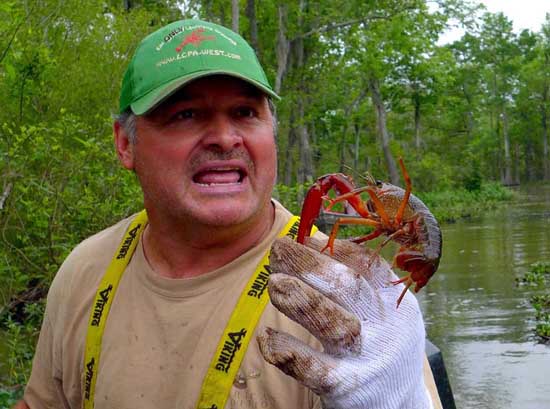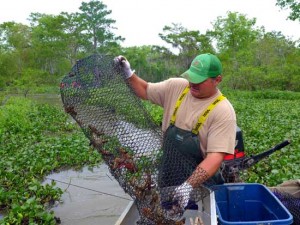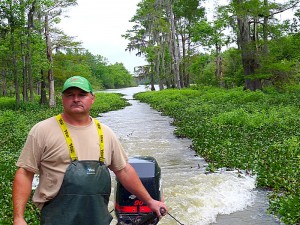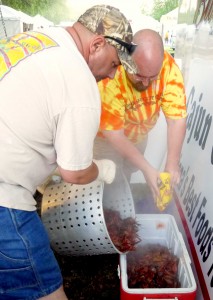 Jody Meche is a third or fourth generation fisherman who maintains about 1,000 crawfish traps in the Atchafalaya Basin. He also happens to be a member of the Henderson Town Council and a board member of the Louisiana Crawfish Promotion & Research Board. So even if he can clown around with a grimace as he shows off a prize crawfish (above), he has the bona fides to be taken seriously on the subject of crawfish. And he’s not modest — not even a little bit. “My crawfish are the best tasting crawfish in the world,” he proclaims.
Jody Meche is a third or fourth generation fisherman who maintains about 1,000 crawfish traps in the Atchafalaya Basin. He also happens to be a member of the Henderson Town Council and a board member of the Louisiana Crawfish Promotion & Research Board. So even if he can clown around with a grimace as he shows off a prize crawfish (above), he has the bona fides to be taken seriously on the subject of crawfish. And he’s not modest — not even a little bit. “My crawfish are the best tasting crawfish in the world,” he proclaims.
 He spent a half day on the Atchafalaya showing some of us in Crawfish College just how deepwater wild fishing is done. Meche fishes a much larger trap than the pond fishermen. His traps stretch 4-5 feet long, which allows the crawfish to crawl to the surface for a sip of air now and then while the trap rests on the bottom.
He spent a half day on the Atchafalaya showing some of us in Crawfish College just how deepwater wild fishing is done. Meche fishes a much larger trap than the pond fishermen. His traps stretch 4-5 feet long, which allows the crawfish to crawl to the surface for a sip of air now and then while the trap rests on the bottom.
The landscape where Meche fishes is phenomenally beautiful and productive swamp within the basin. It could be even more productive, he points out, if the powers that be would use the basin for the purpose created by the Army Corps of Engineers – as flood relief. On Thursday morning, there was more than a 20-foot differential between the height of the Mississippi where it can be let into the basin (33, almost 34 feet) and the height of the basin water itself (under 13 and a half feet). To Meche it makes no sense for people all up and down the Mississippi and Ohio rivers to deal with flood water when the river could be lowered by bleeding out some of the water into the Atchafalaya. Another 5-6 feet would restore the basin to its natural heights readily visible as water lines on the embankments.
 More water would mean a smoother flow and better oxygenation in the basin. It would, in effect, cover up the channeling effects of the spoil banks left behind by oil and gas exploration and pipeline construction. It would also mean bigger and more crawfish. Of course, it would also make the whole basin into an undisputable navigable waterway. That could call into legal question a number of land claims currently providing outside investors with lucrative oil and gas royalties that would otherwise revert to the state. This is all according to some legal views. And litigation runs by Napoleonic code in Louisiana.
More water would mean a smoother flow and better oxygenation in the basin. It would, in effect, cover up the channeling effects of the spoil banks left behind by oil and gas exploration and pipeline construction. It would also mean bigger and more crawfish. Of course, it would also make the whole basin into an undisputable navigable waterway. That could call into legal question a number of land claims currently providing outside investors with lucrative oil and gas royalties that would otherwise revert to the state. This is all according to some legal views. And litigation runs by Napoleonic code in Louisiana.
 Still, Jody and his nephew Casey Bodoin, running a sister boat, quickly gather two big sacks of crawfish — around 70 pounds. They will make a mighty fine boil come evening. The Breaux Bridge Crawfish Festival is about to begin and on the eve of the festivities, all the volunteers who make it happen have a party and picnic on the fairgrounds. We students of Crawfish College are privileged to join, and our crawfish from the trip with Jody Meche are part of the feast. Here Byron Blanchard dumps the just boiled crawfish into a cooler as his son sprinkles them with “swamp dust” – a spice blend that includes salt, paprika, and just a bit of cayenne pepper.
Still, Jody and his nephew Casey Bodoin, running a sister boat, quickly gather two big sacks of crawfish — around 70 pounds. They will make a mighty fine boil come evening. The Breaux Bridge Crawfish Festival is about to begin and on the eve of the festivities, all the volunteers who make it happen have a party and picnic on the fairgrounds. We students of Crawfish College are privileged to join, and our crawfish from the trip with Jody Meche are part of the feast. Here Byron Blanchard dumps the just boiled crawfish into a cooler as his son sprinkles them with “swamp dust” – a spice blend that includes salt, paprika, and just a bit of cayenne pepper.

We just purchase property on 3 Mile Lake near Port Barre. We have water on 3 sides and would like to learn more about catching “supper”!
The basin needs to be used as it was intended, as a spillway. If used to bleed out water into the Atchafalaya basin it would allow flood relief to surrounding areas of the Mississippi river, and promote better fishing for crawfish, and fish in these areas.
Where is the best place to buy live Atchafalaya crawfish?
Breaux Bridge